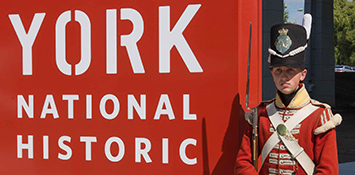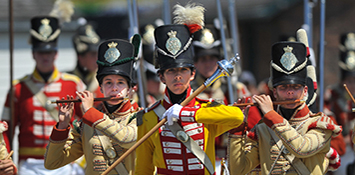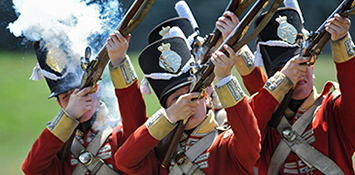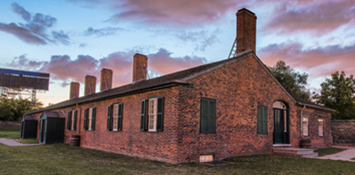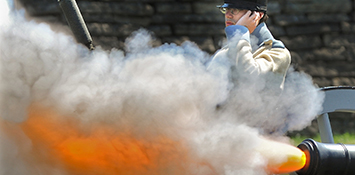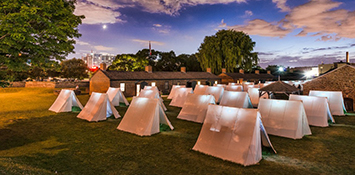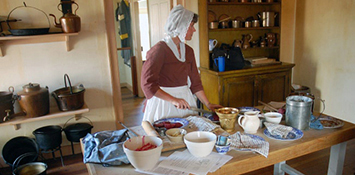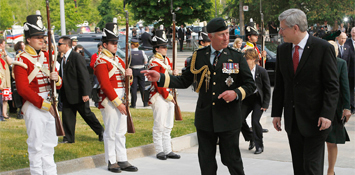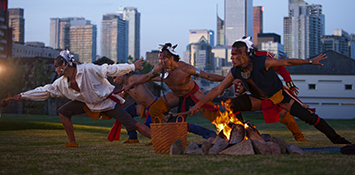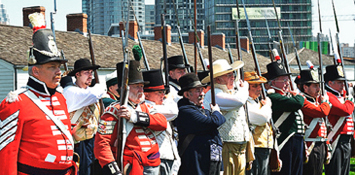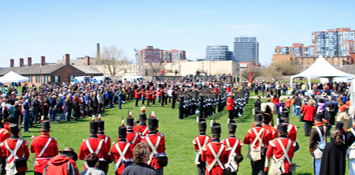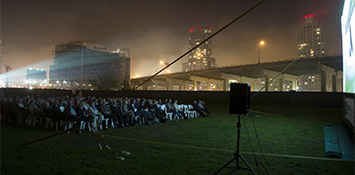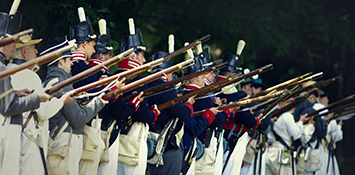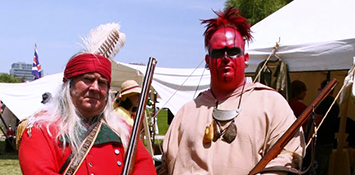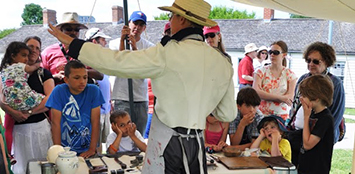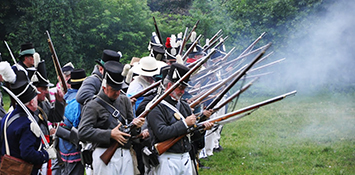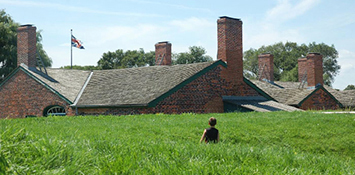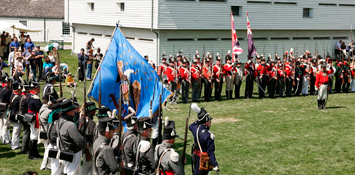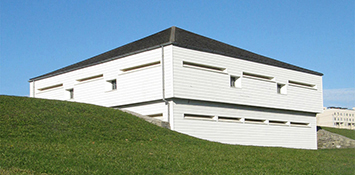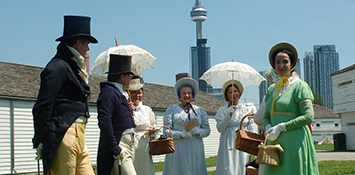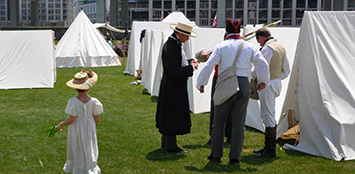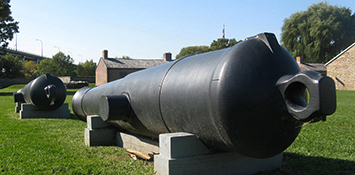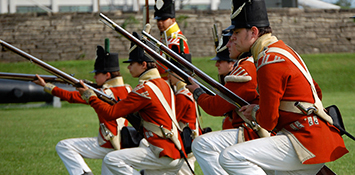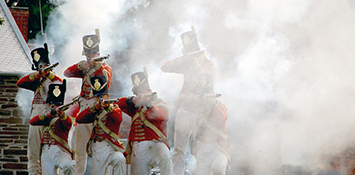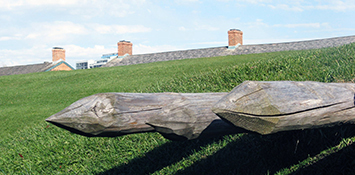Job Opportunities
 The Fort York Guard is made up of high school and university students who come out during the summer months and put on daily demonstrations at the fort as well as performances at various events throughout the city. Our job is made possible by The Friends of Fort York, who employ us throughout the summer to bring animation to Fort York.
The Fort York Guard is made up of high school and university students who come out during the summer months and put on daily demonstrations at the fort as well as performances at various events throughout the city. Our job is made possible by The Friends of Fort York, who employ us throughout the summer to bring animation to Fort York.
The Fort York Guard is broken down into 2 sections, the Squad, and the Fife and Drum Corps. Both sections operate during the summer months and together form the guard. The squad dresses in the red uniform of the Canadian Regiment of Fencible Infantry and fires muskets and the cannon. The drum corps, in a different uniform but representing the same regiment, play the fife or drum and are also responsible for firing the cannon.
Both divisions work 35 hours a week and perform five demonstrations daily throughout July and August. The job starts from the middle to the end of June to allow time for training purposes.
All prospective candidates for employment with the Guard must be be available all summer, from mid June to the end of August including all weekends. Applications are considered at the start of May of each year.
The Friends of Fort York and Garrison Common
250 Fort York Blvd.
Toronto, ON M5V 3K9
Please email This email address is being protected from spambots. You need JavaScript enabled to view it. with your resume and cover letter, or any inquires, by May 1st.
Become a Volunteer with the Guard
 Our volunteer program runs through the Fort York Drum Corps and encourages youth (ages 11–16) to come out and learn the fife or drum and accompanying military drill from the War of 1812 period. During the summer, volunteers are encouraged to come out as often as possible, and to perform with us during our daily demonstrations and special events. Official volunteer practices will be every Sunday throughout the summer months (May–August) from 12 noon–3 pm, but volunteers are more than welcome to come more regularly and to stay until the end of the day at 5 pm. We provide a supportive team environment and are always excited to have enthusiastic volunteers join us during the active guard months of July and August from 10 am–5 pm.
Our volunteer program runs through the Fort York Drum Corps and encourages youth (ages 11–16) to come out and learn the fife or drum and accompanying military drill from the War of 1812 period. During the summer, volunteers are encouraged to come out as often as possible, and to perform with us during our daily demonstrations and special events. Official volunteer practices will be every Sunday throughout the summer months (May–August) from 12 noon–3 pm, but volunteers are more than welcome to come more regularly and to stay until the end of the day at 5 pm. We provide a supportive team environment and are always excited to have enthusiastic volunteers join us during the active guard months of July and August from 10 am–5 pm.
However, as special events are extremely important, we ask that only those volunteers who show a dedication to the corps by practicing and coming out to volunteer practices at least once a week participate in them.
As a volunteer you are treated with the respect given to a member of the Drum Corps, and will learn how to work with other members of a team to create an impressive, historically accurate performance. The overall experience is fun and rewarding; it instils confidence and team values in every member.
Applications are considered at the start of May of each year.
The Friends of Fort York and Garrison Common
250 Fort York Blvd.
Toronto, ON M5V 3K9
For further information please email us at: This email address is being protected from spambots. You need JavaScript enabled to view it.
The Fort York Guard

Fort York Guard on Pause in 2022
We very much regret to report that The Friends have not been able to obtain support from the City to operate the Fort York Guard this summer. The City has decided to put its relationship with The Friends of Fort York on pause to conduct a review of how closely the values of The Friends currently align with the City’s organizational values and what steps might be required based on the outcomes of the process. The City determined that it was necessary to pause the Guard in the spirit of the review process. A timetable for the process has yet to be announced.
The Guard, consisting of the Squad and the Drums, is a joint and cooperative venture by the City of Toronto in partnership with The Friends of Fort York and has been a popular living history attraction at Fort York. We believe this will be the first time since 1955 that the Guard has not appeared at Fort York in the summer - it will certainly be the first time since The Friends of Fort York took on leadership for mounting the Guard in 1999.
We strongly believe that there is a place for living history alongside the many contemporary events that take place at the Fort. The Guard has provided a welcome and challenging summer employment opportunity for students which, in turn, has attracted support through federal grants. It has also fostered camaraderie and spirited competition with similar groups hailing from other historic forts in Ontario.
The Friends have always appreciated and recognized the intense loyalty and professionalism of the students who have served in the Fort York Guard. The quality of their music and drill demonstrations is second to none. We will hope to see a return of the Fort York Guard in 2023.
If you have views on this subject, please send them to This email address is being protected from spambots. You need JavaScript enabled to view it..
The Fort York Guard has been a familiar part of Fort York for over seventy-five years, since the fort opened as a national historic site in 1934. It consists of two sub-units, the Squad (musketmen) and the Drums (musicians). The size of the Guard has varied over the years, from a high of 40, to zero between the mid–1980s and 1994.
Each day, the Guard performs a variety of demonstrations for the fort's visitors during the summer months. These include artillery firing, musical demonstrations, drills, and battle tactics performances. For schedules contact Fort York.
The Friends of Fort York accepted full responsibility for running the Guard in 1999 and has gradually increased its size to 23 students in 2010 not including the younger volunteers in the Drums. Plans call for a Guard of 30 for the celebration of the Bicentennial of the War of 1812. For the last decade, The Friends of Fort York have been responsible for the operation of the Guard. This involves their hiring, training, scheduling, deployment, uniforms, and equipment. It consumes a large part of what The Friends earn from different fundraising functions and activities or receives as donations. Putting such a credible and award-winning squad in the field to animate the fort, in a way nothing else could do as appropriately, would not be possible without assistance from the City of Toronto Culture department and various programmes of the Government of Canada to assist with student summer employment.
If you wish to support The Friends of Fort York and the Fort York Guard, please click here to donate. Help us keep our history alive!
Fort York Drums
The Fort York Drums was founded in 2000 by The Friends of Fort York. The Drums recreates the fifers and drummers of the Canadian Regiment of Fencible Infantry, a regiment raised specifically for the defence of Canada. The Drums has quickly grown to be a recognizable and popular entity at Fort York. It performs daily at the fort during the summer months, and travels throughout the year promoting the fort and its activities. The Drums is made up of a core group of employed students supplemented by volunteers between the ages of 11 and 16.
In 2002, the Fort York Drums recorded its first CD, called To Follow the Drum. This recording – which contains a variety of authentic military music from the War of 1812 period – is available at the Museum Canteen Store. Select the link to listen to "Quickstep 2nd Battalion Royals" a track from To Follow the Drum.
Play Music Track:
Fort York Squad
The Fort York Squad was re-established by the Toronto Historical Board in 1994. Originally, the Guard wore the uniform of the grenadier company of the 8th Regiment of Foot, which was a unit that played a prominent role in the Battle of York in 1813. It now wears the uniform of a battalion company of the Canadian Regiment of Fencible Infantry. This regiment was garrisoned at Fort York in 1815.
The Squad performs daily in conjunction with the Fort York Drums, but it also travels, performing at historic sites across Ontario to promote the fort and at various events in Toronto. The drill performed by the Squad accurately reflects the War of 1812 period, and is taken from original drill manuals used by His Majesty' s forces in England and abroad. Every effort is made to provide an authentic depiction of a squad of soldiers that may have been seen at Fort York in 1815.
The Fort York Squad has competed in the province-wide Fort George Drill competition in Niagara Falls every year since 1999, and has won the competition several times.
Royal Artillery
A significant part of the Fort York Guard, the Royal Artillery detachments man the field guns that are fired daily during the summer months.
The Royal Artillery has been an important part of Fort York since its first construction in 1793. The strength of a fort's artillery often determines the strength of a fort and its ability to repel an attack by land or sea. Fort York has one of Canada's most diverse collections of original guns. This collection dates from the mid-17th century right up to the 1870's, when the British army left Canada. Many of the fort's ordinance are on display around the fort and in a new artillery exhibit in Blockhouse (No. 2).
The Guard's Artillery Detachments fire the fort's reproduction Cohorn mortar, a 1-pounder and a 6-pounder field gun. They wear the Royal Artillery's distinctive blue jackets with yellow regimental lace, along with their unique style shako (caps).
Music
The Fort York Drums plays a variety of music from the late 18th and early 19th century. The music is predominantly British in origin, and written specifically for the fife and drum. The music, selected by the Drum Major and Fife Major, includes formal marches, folk tunes, and duty calls. Every effort is made to select tunes and beatings from original manuscripts.
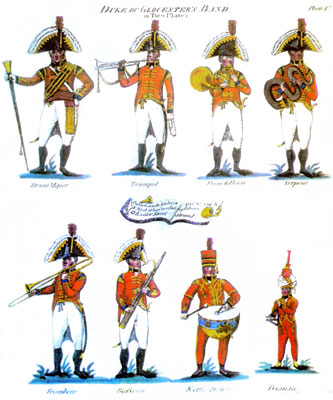 |
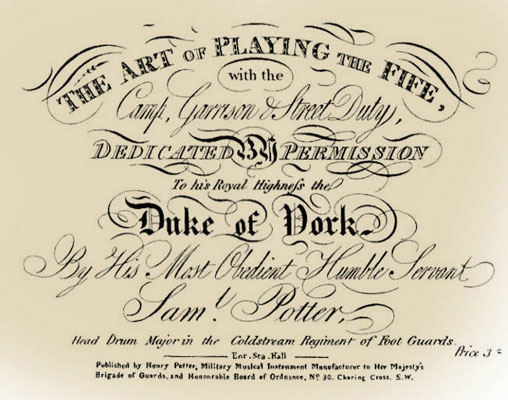 |
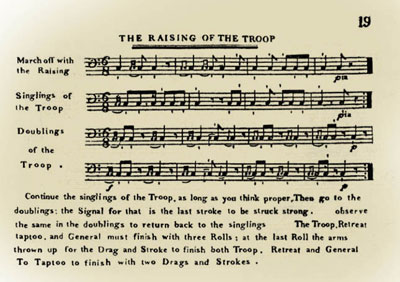 |
Some of the most important sources of historical music include:
- Samuel Potter, 1815
- Aird Collection, 1780–95
- Buttrey Manuscripts, 1790
- Rumrille and Holton, 1780
- Ashworth, 1812
- Clark, 1797
- Rutherford, 1756
The colour illustration depicts The Duke of Gloucester’s Band, 1811. Book cover and drum music example are from The Beating of the Drum, one of the earliest British books on military drumming techniques, published in 1815 in London by the head Drum Major of the Coldstream Regiment of Foot Guards, Samuel Potter.
Instruments
The Fort York Drums plays the two military instruments carried by field musicians of the War of 1812 period, including a B flat fife and tenor side-slung, rope tension snare drum. The fife is a six-holed instrument, played across the body like the modern flute. It is a practical instrument for the military as it does not require significant upkeep in the field. The fife was played in the upper octave, which allowed the instrument to be an effective communication tool, as it could be heard for a great distance.
The drum was typically constructed of a wood shell, although brass shells were also common at this time period. The drum heads were made out of calf skin, which was stretched over wooden hoops and fit tightly to the shell. To give the drum a crisp sound, snares (pieces of dry thin leather twisted tightly) were strung along the bottom head of the drum. Tension was created by ropes and ears that were strung vertically around the drum.
The drum complemented the fife, as it plays in the bass range, and could also be heard for a great distance. This allowed these two instruments to be heard in and around the fort by soldiers working on fortifications, standing sentry, or sleeping in barracks.
Uniforms
The Fort York Drums wears the uniform of the Canadian Regiment of Fencible Infantry, a unit that saw action throughout Canada during the War of 1812, and was garrisoned at Fort York in 1815. It is appropriate that the Drums should represent this regiment, as the fort that stands today was for the most part complete in 1815, and the entire regiment was garrisoned there. This regiment was a yellow-faced battalion, meaning that the regular infantryman wore a red coat with yellow facings (collar and cuffs). This colour distinction allowed commanders to distinguish between regiments, as every regiment was assigned its own facing colour.
The drummers of a non-Royal regiment wore "reversed colours." This means that their coats were yellow with red facings. This reversal allowed the drummers to stand out from the infantrymen. This distinction may have been due to the fact that a Corps of Drums was an object of pride for a regiment, and so it made sense to dress them differently. It is also a functional difference, as music was used to communicate with the army, so it was necessary to be able to identify the drummers quickly in garrison or on the battle field.
Each drummer (or fifer) was issued a fife case and sword. The fife case was likely a brass tubular case, worn over the shoulder and suspended by a belt. The sword was similar to the non-commissioned officer's sword of the period, and was suspended from a sword belt over the opposite shoulder of the fife case. The sword was intended as a symbol of importance rather than a weapon. In addition, many regiments gave their fifers and drummers the more traditional bear skin cap rather than the more common shacko. It is quite possible that the drummers of the Canadian Regiment had bear skin caps.
Muskets
The Fort York Guard carries the Brown Bess musket, which was the typical firearm of the British army during the War of 1812. The musket is one of the longest-used military firearms in history, remaining in official service between the mid 1700s up to 1839. It was a firearm that had many pros and cons, but it was an effective balance of technology and practicality.
View how to load and fire a Brown Bess musket |
Pros:
- The musket could be loaded and fired relatively quickly. A well trained soldier could fire as many as three shots per minute, compared to only one or two shots per minute with a typical rifle of the period.
- The musket was relatively cheap to mass produce.
- The musket had interchangeable parts, which meant that if a part broke while in the field it could easily be replaced.
- The construction of the musket was robust and durable.
Cons:
- The musket was not particularly accurate. This meant that European soldiers fought in long lines and fired together en masse to maximize the effectiveness of the musket.
- The misfire rate was high (estimates are as high as one in six shots misfired).
- A musket is not accurate at distances greater than 100 yards. Close contact was necessary for deadly results.

